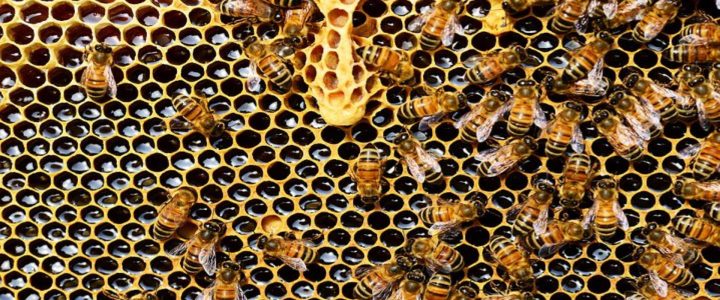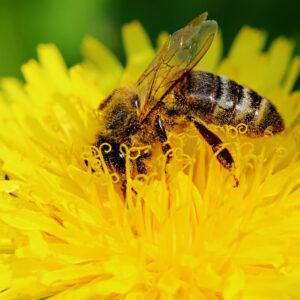
130 million years ago, when flowering plants began to sprout on this planet, their fates went wherever the wind blew. Literally, wind would blow the pollen off of the flower. That’s how flowers made love, and as passionate as it may have been, it was a messy affair that necessitated a lot of pollen. Insects evolved to help out, but the very first ones were a little overeager. They were of the sort that would literally bite the flower off the stem. Pollination would occur but, if you can imagine, it wasn’t the best way of doing business- come to think of it, it’s not unlike the inefficiency that comes with mining for coal or drilling for oil… Finally, bees came around with their hind legs full of bristles that, ever so gently, picked up the pollen. It was a match made in heaven.
Today, on National Honey Bee Day, swrm pays tribute to its mascot and muse. This incredible creature has so much to offer in the way of lessons. Flowers, sensing that they’ve found their soul mates, have not let them go since they first appeared 65 million years ago. Bees are so well adapted to pollinate that they’ve become indispensable to 40 thousand species of flowering plants, and are no stranger to an additional 130 thousand more. Eighty percent of all the flowering plants in the world are pollinated by insects and, of these, the industrious honey bee carries 85% of that work load.
Plants have learned to play the game. They produce nectar for the sole purpose of enticing pollinators, and it’s not simply a case of one and done. Some flowers will provide nectar in surplus in order to capture a bee’s attention, but nectar takes energy to produce; the ideal situation occurs when the plant expends the least amount of energy and resources while maintaining a steady stream of customers. So if one plant is being a little thrifty, the flower in the bush next door may decide to be extra generous, sweetening the deal with a little more nectar, and therefore winning the hearts, minds and habitual visitation of honey bees. It’s a constantly changing cost-efficiency analysis.

Researchers have developed incredible ways observing bees. During the larvae stage of development, they are able to insert microchips into each member of a colony. After observing these insects throughout their entire lifecycle, recording their behaviors, their comings, their goings, honey bees have come to be known as “superorganisms”: the honey bee colony functions so efficiently, that it appears as if it were a single entity, rather than a collective with upwards of 50 thousand individual members. Part of the reasoning for this is that honey bees don’t have a central authority figure, no general who delights in doling out commands left and right.
That isn’t to say that they don’t take suggestions from each other. A scout, whose job it is to explore and find new sources of nutrition, will tell the forager to go over yonder for a tasty meal. The forager goes, takes a sip for himself and then brings half of her body weight back in nectar to the hive for the general welfare of the whole. Scientists have observed that some honey bees can be “lazy” and go out only one to three times a day on a foraging mission. On the other hand, there are those who will go out ten times, visiting up to three thousand flowers, and possibly traveling over six miles in a single day. Again, like the flowering plants producing the nectar, it’s a cost-efficiency estimate for the honey bee: if a honey bee travels six miles to fill up its tank with 40 mg of nectar, it will need just about that much to get back to the hive.
In 2006, a worldwide phenomenon occurred: the honey bee was disappearing in extraordinarily large numbers. They simply jumped ship and were nowhere to be found, prompting scientists to dub it Colony Collapse Disorder. Though the population has since bounced back, the concern remains because no one has come up with a definitive answer of why it happened. Absence does make the heart grow fonder; experts agree that if the honey bee population were permanently reduced, it could spell catastrophe in a number of ways. A trip to the supermarket would be particularly depressing, as scores of produce would start disappearing from the shelves: strawberries, onions, celery, almonds, tomatoes, lemons, apples. It’s estimated that the honeybee provides $20 billion a year to the US agricultural industry.
Everything about the honey bee is mindboggling, as if someone were making it up, but the numbers do not lie: bees buzz because their wings flap nearly 12 thousand times per minute; a single bee makes only 1/12th of a teaspoon of honey in its lifetime, which is why the queen bee must lay over two thousand eggs per day during the summer months; a jar of honey requires nectar from 2 million flowers, and for bees to fly over 90 thousand miles to collect it. If that isn’t impressive enough, consider the fact that a honey bee needs only two tablespoons of honey to fuel a journey around the world and perhaps you’ll find yourself as one of the 211 thousand beekeepers that are in the United States alone. All this and more are reasons the calendar honors the industrious honey bee today, and why we at swrm look to it as the perfect model for energy efficiency!



